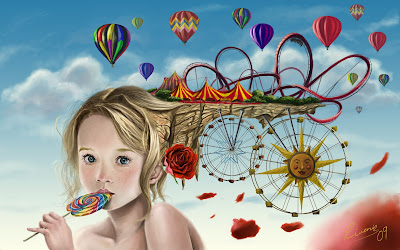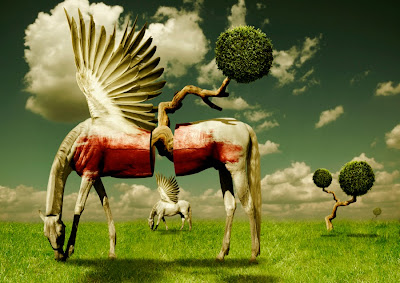Our next project is coming. We have to make a surrealism image as our dream or advertising poster. we started with research and suddenly Yasmin said about how artist get ideas to make a surreal image.
That game called 'The Exquisite Corpse'. we just prepared 1 piece of paper and pencil. we write down a word, then fold the paper down and pass it to the next person, so the next person can not look the word. Then my friend write down a word again and so on. After one round, we open the paper and we looked so much random words and we made sentences with those words. That is so random and that is surrealism. We also can change the word with draw an object.
 |
| i got dolphin, glue, iPod, elephant, and price. |
 |
| i got watch, glasses, stars, castle, and chair. |
Surrealism is a cultural movement that began in the early 1920s, and is best known for its visual artworks and writings. The aim was to "resolve the previously contradictory conditions of dream and reality." Artists painted unnerving, illogical scenes with photographic precision, created strange creatures from everyday objects and developed painting techniques that allowed the unconscious to express itself.
Surrealist works feature the element of surprise, unexpected juxtapositions and non sequitur; however, many Surrealist artists and writers regard their work as an expression of the philosophical movement first and foremost, with the works being an artefact. Leader André Breton was explicit in his assertion that Surrealism was above all a revolutionary movement.
Surrealism developed out of the Dada activities during World War I and the most important center of the movement was Paris. From the 1920s onward, the movement spread around the globe, eventually affecting the visual arts, literature, film, and music of many countries and languages, as well as political thought and practice, philosophy, and social theory.
The first Surrealist work, according to leader Breton, was Les Champs Magnétiques (May–June 1919). Littérature contained automatist works and accounts of dreams. The magazine and the portfolio both showed their disdain for literal meanings given to objects and focused rather on the undertones, the poetic undercurrents present. Not only did they give emphasis to the poetic undercurrents, but also to the connotations and the overtones which "exist in ambiguous relationships to the visual images."
Because Surrealist writers seldom, if ever, appear to organize their thoughts and the images they present, some people find much of their work difficult to parse. This notion however is a superficial comprehension, prompted no doubt by Breton's initial emphasis on automatic writing as the main route toward a higher reality. But—as in Breton's case—much of what is presented as purely automatic is actually edited and very "thought out". Breton himself later admitted that automatic writing's centrality had been overstated, and other elements were introduced, especially as the growing involvement of visual artists in the movement forced the issue, since automatic painting required a rather more strenuous set of approaches. Thus such elements as collage were introduced, arising partly from an ideal of startling juxtapositions as revealed in Pierre Reverdy's poetry. And—as in Magritte's case (where there is no obvious recourse to either automatic techniques or collage)—the very notion of convulsive joining became a tool for revelation in and of itself. Surrealism was meant to be always in flux—to be more modern than modern—and so it was natural there should be a rapid shuffling of the philosophy as new challenges arose.
Surrealists revived interest in Isidore Ducasse, known by his pseudonym Comte de Lautréamont, and for the line "beautiful as the chance meeting on a dissecting table of a sewing machine and an umbrella", and Arthur Rimbaud, two late 19th-century writers believed to be the precursors of Surrealism.
Examples of Surrealist literature are Artaud's Le Pese-Nerfs (1926), Aragon's Irene's Cunt (1927), Péret's Death to the Pigs (1929), Crevel's Mr. Knife Miss Fork (1931), Sadegh Hedayat's the Blind Owl (1937), and Breton's Sur la route de San Romano (1948).
While Surrealism is typically associated with the arts, it has been said to transcend them; Surrealism has had an impact in many other fields. In this sense, Surrealism does not specifically refer only to self-identified "Surrealists", or those sanctioned by Breton, rather, it refers to a range of creative acts of revolt and efforts to liberate imagination. In addition to Surrealist ideas that are grounded in the ideas of Hegel, Marx and Freud, Surrealism is seen by its advocates as being inherently dynamic and as dialectical in its thought.
 |
| i love this one because the girl's expression, the hair, and the colours. |
 |
| i love this one to, tricky and we can rotate. but looks scary, the man is just like a ghost. :\ |
 |
| one of my favourite, titled "this is not pipe" and we see a pipe. The artist said this is not a pipe because this is a /an picture/image. little joke. |
In my opinion, the different between modern surrealism and the 1920s artwork are :
- The image (1920 use canvas and brush, though the modern using photoshop and digital)
- 1920s artworks are harder to understand and sometimes we don't know the object because too surreal
- 1920s artworks are used as the expression and way for the artist tell their emotion and feelings (in world war II)
- Modern surreal artwork is more simple, the object is around us everyday
- Modern surreal has branch function : advertising (maybe it is to attract people attention because as we know, surreal image always make people stop the activity, look at the image, and thinking what is the meaning.

























































